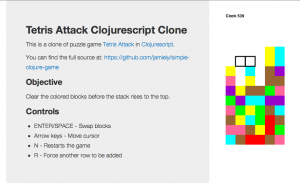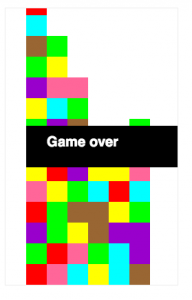Intro
Having completed a simple implementation of the game Breakout in Clojure, I decided my next Clojure project should be doing something with ClojureScript. Not only would it provide an opportunity to continue Clojure practice, but I’d be able to leverage existing knowledge I have about JavaScript (probably the language I am most familiar with), and I could possibly use it in the future for a web project. Note that I’ve only tested this with the most recent version of Chrome. Performance is not great right now, but can be much improved. Here’s a demo.
Clojure v ClojureScript
I found the process of building projects, sharing code between Clojure and Clojurescript, and building the source to be very straightforward. I used cljsbuild to accomplish many of these needs. Especially useful was the repl which can be used to communicate with ClojureScript code running in the browser.
There were two sources of headaches I had with working with ClojureScript, as compared to Clojure.
- I had to create compatability namespaces to wrap thigngs that are available in
clojure.corebut notcljs.core - I found a couple things (hex-string support) that were supported in clojure.core and not cljs.core, but were not documented.
- When cross-compiling Clojure code for use in ClojureScript, I did not see in the documentation how to make namespace functions exportable. Admittedly, I might find my answer easily if I were to ask on the mailing list. This means I haven’t gotten advanced compiling working yet, and the compiled script file is large at 1MB.
The Game
I decided to work on a clone of the game Tetris Attack, which has provided me with hundreds of hours of entertainment. The object of the game is to match 3 or more blocks. The complexity of the game comes in setting off chain reactions of matches.
Methodology
The game is represented as a simple HashMap of keys and properties, that looks something like the following:
1 2 3 4 5 6 7 8 | {:grid {:blocks [{:type :#FF0000 :position [1 1]} {:type :falling :block {...} :falling-to [3 3] :ticks 15} {:type :swap :blocks [...] :ticks 10} ...] :rows 10 :cols 6 } :clock 10} |
Blocks are determined by type. The simplest blocks store their color as their type. Other types have specific meanings. For example, a “falling” block is one which is falling down a grid column (as if pulled by gravity).
Some of these blocks have a property called :ticks, which determines the clock ticks left for the action to complete. For example, a falling block with 10 ticks left, will take 10 clock ticks to finish falling, at which point it may be resolved into a normal block.
In this way, the entire game-state is stored, and separate interface functions can work to alter the game state.
In terms of mutability, a single atom in the entrypoint namespace stores the entire game state and interface state. The rendering code is entirely separate and may operate on arbitrary game states.
Rendering
The rendering code is in the display namespace in a ClojureScript-specific file that performs drawing on an HTML canvas object. This namespace, along with the entrypoint namespace provide the specific code necessary to drive the web interface. Although ideally there’d be a namespace that contains only functions requiring implementation to support different platforms, display and entrypoint are not at that point. Still, implementing a version with an interface using three.js or using Java Swing should be fairly trivial.
Learning
Most of the projects I do are for learning rather than anything practical. Here are some of the main things I’ve learned about working on this project:
- Some new Clojure techniques, such as using
partialandinto, the threading operator, testing withclojure.test, and some more about how namespacing works. - How to work with ClojureScript – This involves syntax, building, debugging, crossovers, interop, and testing.
- How to implement a game almost entirely using immutable structures.
Media
You can find updated links to media as well as the full source in the project README. Here are (current as of the post date) screenshots and screencasts. Here’s a demo of the project. Please note that the script file is fairly hefty at (1 MB) since I haven’t gotten advanced compiling working yet.

